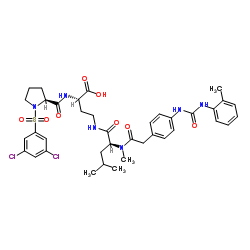327613-57-0
| Name | BIO-5192 |
|---|---|
| Synonyms |
(2S)-2-({1-[(3,5-Dichlorophenyl)sulfonyl]-L-prolyl}amino)-4-({N-methyl-N-[(4-{[(2-methylphenyl)carbamoyl]amino}phenyl)acetyl]-L-leucyl}amino)butanoic acid
MFCD26408178 55W0N209OS Butanoic acid, 2-[[[(2S)-1-[(3,5-dichlorophenyl)sulfonyl]-2-pyrrolidinyl]carbonyl]amino]-4-[[(2S)-4-methyl-2-[methyl[2-[4-[[[(2-methylphenyl)amino]carbonyl]amino]phenyl]acetyl]amino]-1-oxopentyl]amino]-, (2S)- BIO-5192 |
| Description | BIO5192 is a selective and potent integrin α4β1 (VLA-4) inhibitor (Kd<10 pM). BIO5192 selectively binds to α4β1 (IC50=1.8 μM) over a range of other integrins. BIO5192 results in a 30-fold increase in mobilization of murine hematopoietic stem and progenitors (HSPCs) over basal levels[1][2]. |
|---|---|
| Related Catalog | |
| In Vivo | The combination of BIO5192 (1 mg/kg; i.v.) and Plerixafor (5 mg/kg; s.c.) exert an additive effect on progenitor mobilization[1]. BIO5192 (30 mg/kg; s.c; bid; during days 5 through 14) delays paralysis associated with EAE (experimental autoimmune encephalomyelitis)[2]. BIO5192 (1 mg/kg, i.v.) shows the terminal half-life is 1.1 h. IO5192 (3, 10, and 30 mg/kg; s.c.) shows half-lives of 1.7, 2.7, and 4.7 h, respectively. The blood plasma curves show that the AUC for the s.c. route of administration increased about 2.5-fold from 5,460 h*ng/ml for the 3 mg/kg dose to 14,175 h*ng/ml for the 30 mg/kg[1]. Animal Model: C57BL/6J x 129Sv/J F1 mice[1] Dosage: 1 mg/kg (with Plerixafor: 5 mg/kg) Administration: I.v. Result: Exerted an additive effect on progenitor mobilization. Animal Model: Healthy female Lewis rats weighing 150g[2] Dosage: 30 mg/kg Administration: S.c; bid; during days 5 through 14 Result: Showed a 3-day delay in onset of disease. |
| References |
| Density | 1.4±0.1 g/cm3 |
|---|---|
| Molecular Formula | C38H46Cl2N6O8S |
| Molecular Weight | 817.778 |
| Exact Mass | 816.247498 |
| LogP | 5.10 |
| Index of Refraction | 1.625 |
